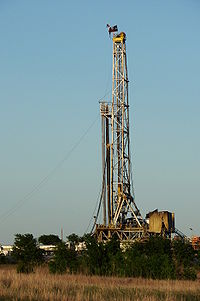| Fracking |
|---|
 |
| By country |
| Environmental impact |
| Regulation |
| Technology |
| Politics |
A proppant is a solid material, typically sand, treated sand or man-made ceramic materials, designed to keep an induced hydraulic fracture open, during or following a fracturing treatment, most commonly for unconventional reservoirs. It is added to a fracking fluid which may vary in composition depending on the type of fracturing used, and can be gel, foam or slickwater–based. In addition, there may be unconventional fracking fluids. Fluids make tradeoffs in such material properties as viscosity, where more viscous fluids can carry more concentrated proppant; the energy or pressure demands to maintain a certain flux pump rate (flow velocity) that will conduct the proppant appropriately; pH, various rheological factors, among others. In addition, fluids may be used in low-volume well stimulation of high-permeability sandstone wells (20 to 80 thousand US gallons (76 to 303 kl) per well) to the high-volume operations such as shale gas and tight gas that use millions of gallons of water per well.
Conventional wisdom has often vacillated about the relative superiority of gel, foam and slickwater fluids with respect to each other, which is in turn related to proppant choice. For example, Zuber, Kuskraa and Sawyer (1988) found that gel-based fluids seemed to achieve the best results for coalbed methane operations,[1] but as of 2012, slickwater treatments are more popular.
Other than proppant, slickwater fracturing fluids are mostly water, generally 99% or more by volume, but gel-based fluids can see polymers and surfactants comprising as much as 7 vol%, ignoring other additives. Other common additives include hydrochloric acid (low pH can etch certain rocks, dissolving limestone for instance), friction reducers, guar gum, biocides, emulsion breakers, emulsifiers, 2-butoxyethanol, and radioactive tracer isotopes.
Proppants have greater permeability than small mesh proppants at low closure stresses, but will mechanically fail (i.e. get crushed) and produce very fine particulates ("fines") at high closure stresses such that smaller-mesh proppants overtake large-mesh proppants in permeability after a certain threshold stress.[2]
Though sand is a common proppant, untreated sand is prone to significant fines generation; fines generation is often measured in wt% of initial feed. One manufacturer has claimed untreated sand fines production to be 23.9% compared with 8.2% for lightweight ceramic and 0.5% for their product.[3] One way to maintain an ideal mesh size (i.e. permeability) while having sufficient strength is to choose proppants of sufficient strength; sand might be coated with resin, to form curable resin coated sand or pre-cured resin coated sands. In certain situations a different proppant material might be chosen altogether—popular alternatives include ceramics and sintered bauxite.
- ^ Mader, Detlef (1989). Hydraulic proppant fracturing and gravel packing. Amsterdam: Elsevier. p. 473. ISBN 0-444-87352-X.
- ^ "Physical Properties of Proppants". CarboCeramics Topical Reference. CarboCeramics. Archived from the original on 18 January 2013. Retrieved 24 January 2012.
- ^ "Critical Proppant Selection Factors". Fracline. Hexion. Archived from the original on 11 October 2012. Retrieved 25 January 2012.